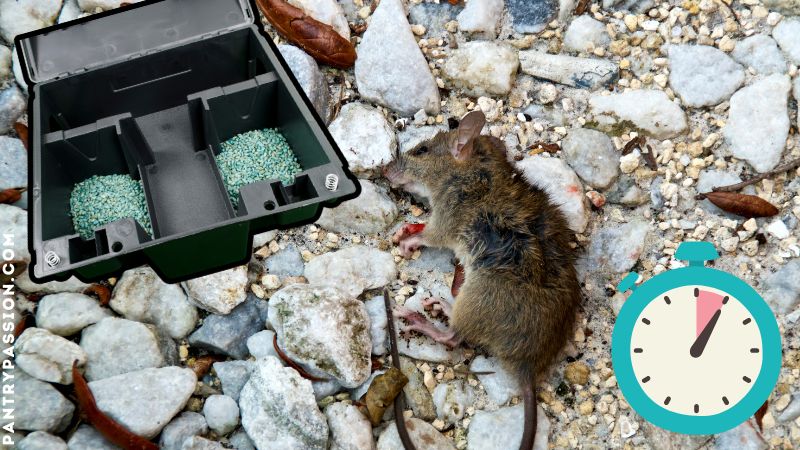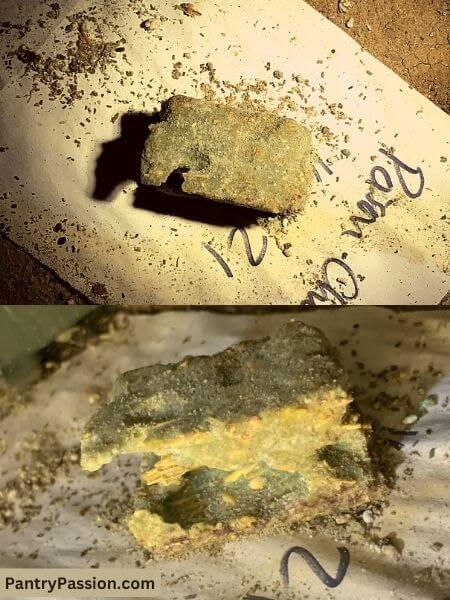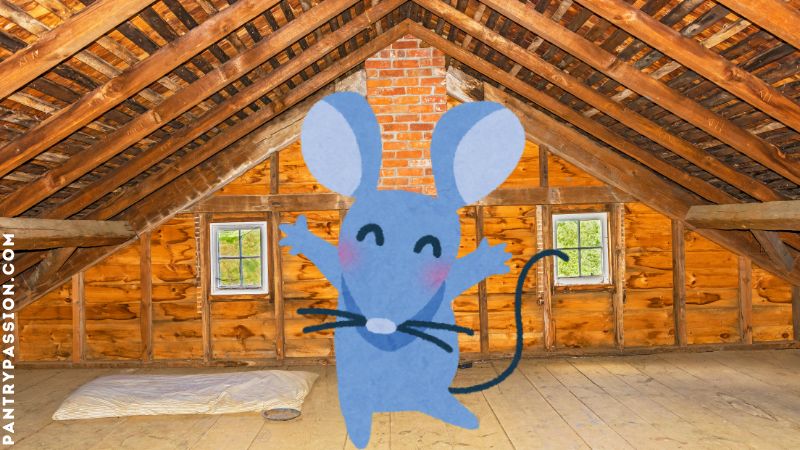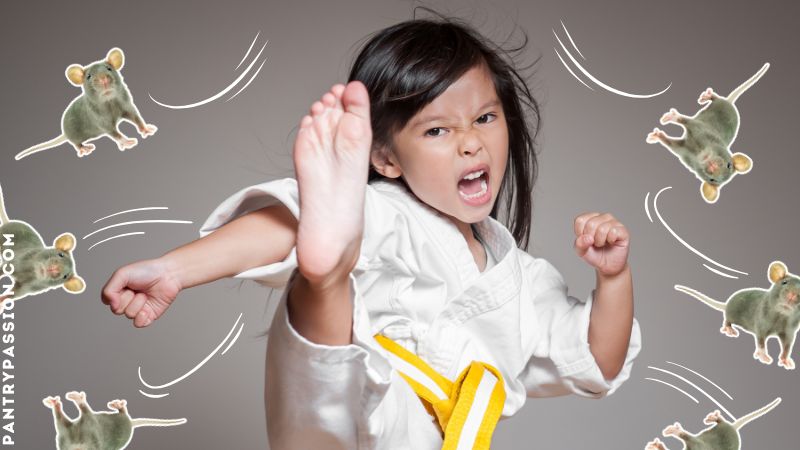The Best Fluffy Pancakes recipe you will fall in love with. Full of tips and tricks to help you make the best pancakes.

Rat & Mouse Poison: What Works, What Backfires, and What You Should Know
If you’re staring down a rodent invasion and thinking poison is your silver bullet—hold that thought. This post dives into the gritty truth behind commercial rodenticides, from bait fatigue to brand-switching strategies that keep mice guessing.
We explore why some poisons lose effectiveness over time (and why this farmwife switches them up), how rodents outsmart your defenses, and what alternatives (like fertility control bait or natural deterrents) might be safer for homes with pets and kids.
DON’T MISS Pantry Passion’s Complete Article List for Mouse & Rat Prevention!
Table of Contents
- How Does Rodent Poison Work?
- Pet-Safe Mouse Poison & Secondary Poisoning
- Powdered Rat Poison and Rat Spray That Kills
- Pet-Safe Rat Poisons (with lower risk)
- What is “Just One Bite Rat Poison”?
- Homemade Rat Poison
- Ethics of Using Mouse & Rat Poison
- What is the Best Rat Poison?
- How Much Poison to Kill a Rat or Mouse?
- How Long Does Mouse Bait Take to Work?
- Does Rat Poison Expire?
- How to Dispose of Mouse Poison
- What Are Mouse Bait Blocks & Bait Stations?
How Does Rodent Poison Work?
It’s not a secret why folks choose rat poison: you can have a rodent infestation cleared up in just a couple of weeks. When I say “rat poison” I’m also talking “mouse poison” – same product for both species.
Rodenticides cause death by internal bleeding, their body will begin to slowly shut down and they will die. During this time of suffering the rodent will actually look for a safe place, such as it’s nest, to be. Inside of walls/floors/ceilings that aren’t regularly accessible to us are other places they may deem safe. That’s the drawback of using rat poison – it can often be a mystery where the dying rat is – this may result in waiting out the stench of the decomposing body.
It is a misconception that mice feel so parched from poison, that they search for water. There are homemade mouse food bait concotions remedies that do trigger this, like dehydrated potato flakes. I included a full list of homemade mouse poison in this article for reference.

OldHouse.blog also breaks this down, noting that anticoagulant rodenticides (the most common type) cause internal bleeding—not dehydration. While dehydration might occur as a secondary effect, it’s not the primary mechanism of death.
Mouse/rat poisons come in many forms: pellets, blocks, liquid baits, powder, and gel baits. Here on the farm, we use bait stations filled with bait blocks. In the house, I toss up bait packets filled with pellets up into my attic and inside of my garage.
The bait packets are some type of paper – mice can easily chew through it. It’s not necessary to open the package and scatter it. After the mice have munched, they leave crumbs/dust – remains of the former pellets.
Rat Poison Alternatives
Hey, I respect that you’re considering alternatives to rat poison. I did a l little digging around, and found some other options to using rat poison – read here.
Rat Poison That Kills Without Odor
Some of you out there may even wonder if there is mouse poison that doesn’t result in a stinking, dead mouse (and believe me, that foul smell lasts even longer with a decomposing rat body!). There are rodent poisons specifically designed to minimize or eliminate odor after death.

Gardening Dream takes a deep dive into each one of these low-odor products:
- RatX: A non-toxic, eco-friendly formula that dehydrates rodents without harming pets or wildlife.
- Kaput Rat & Mouse Bait: Designed to reduce odor and secondary poisoning risks.
- Farnam Just One Bite II: A fast-acting bait with reduced smell and high effectiveness.
- Contrac Blox: A widely used bait block that’s known for minimizing odor and being safer around non-target animals.
💡 Important caveats:
- Even with odor-reducing poisons, rodents may still die in inaccessible places (like inside walls), which can cause lingering smells.
- These products are often marketed as “no-odor”, but results can vary depending on environmental conditions and where the rodent dies.
Pet-Safe Mouse Poison & Secondary Poisoning
Secondary poisoning—also known as relay toxicity—is what happens when an animal is poisoned not by eating the bait directly, but by consuming another animal that has already ingested poison. It’s a major concern for dog and cat lovers (and birders) everywhere.
Some folks argue that secondary poisoning is extremely rare. They claim that the number of whole mice needed to be consumed for an animal even as small as a house cat, is in the hundreds.
A 2022 study in Ontario found rodenticide in 62% of dead raptors tested. A study published in 2020 by Tufts Wildlife Clinic at Cummings School of Veterinary Medicine showed that 100% of the Red-tailed Hawks admitted into their clinic tested positive for the presence of rodenticides. -Source: Audobon
It doesn’t necessarily mean that eating a poisoned rodent is a death sentence, but it does mean the poison is showing up in their system. I am alarmed at the 100% figure above. We don’t have control over wild birds and animals finding dead rodents, we do have control over our pet dogs and cats.

If you’re worried about your dog or cat directly eating rat poison, you have a good reason to be. Many kibble pet foods are grain-based, so what’s so different from them being tempted by rat poison?
What about birds – wil they eat rat poison? If given the opportunity, they might, but this would be rare. For free-range chickens foraging out in your farmyard, they might come across loose rat poison. A pigeon might go for it, but if you’ve taken the right precautions, those birds will never have the chance.
Take precautions and store rat poison up on shelves where dogs and cats can’t reach it. Most buckets of bait have very difficult lids to pry or screw off – for a reason. Best practice is to not even place poison where cats and dogs roam.
I place poison in my farmhouse basement, but make sure it’s blocked with heavy buckets the dog can’t move. Outside, use bait stations that your other pets and wild animals can’t get into. Never scatter poison that wild birds and animals can accidentally ingest.
Powdered Rat Poison and Rat Spray That Kills
Toxic “tracking powders” containing potent rodenticides are limited to professional pest control operators for safety reasons. It’s BAD STUFF. It’s poisonous to humans, pets, children. Licensed operators need to wear gloves when using it, and be responsible for the storage where humans and pets can’t access it.
From an anonymous Reddit user: “The powder is applied to entry points, nests, rat runs and pretty much anywhere that we know the rodent will come into contact with it. Doing this takes advantage of the rat’s natural grooming habit. They rub up against the powder or walk over it and once it’s on their feet and/or fur they then groom themselves, thus ingesting it without realising. If the problem is really bad then we essentially blanket coat the roof space (provided it’s not being used for storage) and nail them easily.”
When handling rodent poison and equipment in any form, always wear plastic gloves. This is both for your safety, and to prevent transferring human scent to the poison. Mice and rats have incredible smell detection and can avoid your best efforts to trap them.
-Farmwife Renee, PantryPassion.com
Don’t confuse this product with the powdered natural repellents sold on Amazon. The average consumer can purchase them – they’re deterrents, NOT poison.
People ask, so I’m going to tell you: there really isn’t a spray products that kills rats. There are natural rat spray deterrents, you can even make your own (see my mega article on that).
Professional fumigation: In severe cases, pest control services may use chemical treatments that act like airborne poisons, but these are not available as consumer-grade sprays.
Pet-Safe Rat Poisons (with lower risk)
Pet safety is a huge concern when dealing with rodent control. While no poison is 100% risk-free, some products are formulated to be significantly safer around pets due to their ingredients, delivery method, or low toxicity levels.
| Product Name | Active Ingredient | Pet Safety Score¹ | Notes |
|---|---|---|---|
| RatX by EcoClear | Corn gluten & sodium chloride | 🟢 1 (very safe) | Targets rodent digestive systems only; non-toxic to pets and wildlife |
| MouseX Throw Packs | Corn gluten & sodium chloride | 🟢 1 (very safe) | Targets rodent digestive systems only; non-toxic to pets and wildlife |
| Kaput Rat & Mouse Bait | Warfarin | 🟢 3 (low risk) | Slow-acting anticoagulant with antidote (Vitamin K); low secondary poisoning risk |
| Tomcat All-Weather Bait Chunx | Diphacinone | 🟡 5 (moderate risk) | Requires multiple feedings; more toxic than warfarin but less than acute poisons |
| d-Con Corner Fit Bait Station | Cholecalciferol (Vitamin D3) | 🟡 5 (moderate risk) | No secondary poisoning risk; toxic only in large doses |
Note: The safety score ranges from 1 (safest) to 10 (most dangerous), based on risk to pets if accidentally ingested.
Tips for Safer Use
- Use tamper-resistant bait stations to prevent pet access.
- Place bait in inaccessible areas (e.g., behind appliances, inside crawl spaces).
- Consider non-toxic traps like the A24 CO₂-powered rat trap, which is pet-safe and humane.

- The only rodenticide with no risk of harming your cats is MouseX. The active ingredients are safe for people, non-rodent pets, and other wildlife.
- pet friendly mouse poison
How to Protect Pets From Rodent Poison
My neighbor has an ingenious system of homemade PVC tubes fashioned in a “T” form (similar to this commercial Top Loader Black Plastic Rodent Bait Station). The forms were tacked down to the ground with wires. Each side of the top of the T is an entry point where mice can get access to the poison. The leg of the T is for securing to the ground with a long u-shaped wire. This prevents your pet or the neighbor’s pet from getting into it.
Reddit user cadred68 offered more explanation, “[Use] 2 pieces of pvc pipe (we used 4 “ dia) separated by a ‘T’ fitting… one part of the ‘T’ should be a smaller diam and be able to have a cap. The large pieces of pipe should be longer than any cat can reach to the center. The little side of the ‘T’ is your fill tube. The whole thing put together approximately 3-4 ft long.”
I recall my neighbor’s contraption being more like 6 inches long at the most. Bait boxes are designed so only mice and rats can enter – not your farm cats, racoons, etc.
What is “Just One Bite Rat Poison”?
It sounds like a miracle, doesn’t it? A product that claims to kill a rat if they take “just one bite” of the poison.
Experienced pros recommend avoiding use of Just One Bite because it is pretty darn lethal, and the swiftness in the death. If a bait kills too quickly, surviving rats may associate the taste or smell with danger and avoid it in the future. Slower-acting poisons (like anticoagulants) allow rats to consume a lethal dose without realizing it’s harmful. -Source: Reddit

Just One Bite is a well-known brand of rodenticide designed to eliminate rats and mice quickly and effectively. It’s really the choice in the name that catches people’s attention.
KEY FEATURES:
- Active Ingredient: Most products in the Just One Bite II line contain bromadiolone, a second-generation anticoagulant. It causes internal bleeding and typically requires only one feeding for a lethal dose.
- Fast-Acting: Rodents may die within a few days of consuming the bait, reducing the chance of bait shyness.
- Palatable Formula: Made with grains and seeds to attract rodents. Some products include nibble ridges to encourage chewing.
- Product Forms:
- Bars: Can be broken into smaller pieces for multiple placements.
- Chunks and Pellets: Ideal for bait stations.
- Bait Stations: Preloaded options for safer residential use with different active ingredients like bromethalin or diphacinone.
Because Just One Bite is highly toxic to pets, wildlife, and humans, it is restricted to use in agricultural settings.
Homemade Rat Poison
The experts will tell you to shy away from homemade rat poison. All I can tell you is that there is hundreds of years of homesteader wisdom passed from neighbor to neighbor. This word-of-mouth DIY formulations have their place.
Mixing these ingredients together will cause bloat in a rodent’s stomach; rodents can’t expel gas and die. Baking soda is a typical ingredient. However, it’s not a quick or reliable method of killing mice. If a mouse does ingest a lethal amount, it could take anywhere from a few hours to a couple of days for the effects to set in. Most mice won’t eat enough for it to work.
- Mice can’t burp or pass gas.
- When they ingest baking soda, it reacts with stomach acids to produce carbon dioxide.
- The gas builds up internally, causing fatal bloating or rupture.
How to use it: Mix equal parts of baking soda with something tasty like peanut butter, sugar, or cocoa powder. Roll into small bait balls and place them near mouse activity zones — along walls, behind appliances, or near droppings.
As Rest Easy Pest Control puts it, homemade mouse bait recipes consist of a base, something sweet, and a “glue”:
- Peanut butter + baking soda 50/50
- Sugar cookie mix + baking soda 50/50
- Jiffy corn bread/corn muffin mix + baking soda 50/50
- Peanut butter + dry powder cement mix
- Plaster of Paris powder mixed into chocolate
- Soup powder mixed in with chocolate – leave out to harden in small plastic dish
- Empty a D3 oil capsule (a single 5000 IU tablet), and mix it with peanut butter. Place small balls around the house and wait for a couple of days -Source: Primal Survivor
“My dad used to use drained can corn and added plaster of Paris to it in a pie tin. Then he would place a tin with water in it a few feet away. The rodents eat the “plaster corn” then drink. The plaster eventually hardens inside them and they die. Carcass doesn’t smell either.” -Youtube member @kellypermuy4375
How Effective Are They?
- Mice are cautious eaters: They have an excellent sense of smell and tend to avoid unfamiliar substances, especially if the bait smells off or has a strange texture.
- Gas buildup theory: Baking soda reacts with stomach acid to produce carbon dioxide, which mice supposedly can’t expel. This could lead to fatal internal pressure—but only if they ingest enough.
- Inconsistent results: Some mice may survive or only experience discomfort. Others might die slowly, which raises ethical concerns.
Success is hit-or-miss. Baking soda might seem like a gentle DIY fix, but it’s neither humane nor consistently effective. According to Lori Lynn’s, even though baking soda is safe around pets, traditional mouse traps still have a much higher success rate over a baking soda bait mix.
There is no scientific evidence that hard ingredients (like plaster of Paris or powdered cement mix) are effective mouse bait, either.
There are many homemade concoctions to kill mice. I would fill you in here, but Tips Bulletin did such an outstanding job that I will direct you to the Tips website.
Ethics of Using Mouse & Rat Poison
Rat poison leads to death by bleeding internally. I’m not going to debate that. Not everyone has the same feelings about ending the life of rats and mice, I respect that.
I will offer first-hand accounts when people were pushed too far:
Reddit member NLA4790 shares “That never ending scratching or scuttling noise in the wall, plus a crying wife, plus making sure every single scrap crumb and morsel of food is in metal containers, the floor is mopped down every night before bed and even a take away pizza goes in the oven for safety. It gets thin real fast. We were basically mostly done with our mice problem in four or five weeks [of using poison]…”
Reddit user East_Letter3972 chimes in, “Anyone’s that saying don’t use poison, talk to me when they are crawling on you or your kids’ face at night. Then we’ll see how much you care.”

East_Letter3972 adds, “Last year they chewed through the water line for my reverse osmosis system and that ruined the cabinets. They ate through starter wires on my riding mower.”
I myself, can attest to rats chewing through water lines leading to the washing machine on a main floor at a friend’s house. This resulted in gallons of water pouring down into the basement. The family had to completely remove all of the carpet and tiles. It was a nightmare.
What is the Best Rat Poison?
Here on the farm, there’s a bit of folklore we swear by: always rotate your rat bait brand. Go into any farm supply store and you’ll see multiple options on the shelf, and that’s not a coincidence.
At my local farm supply store, I have two options, the TomCat brand and Hawk. Prowler is another brand. It’s more convenient for me to pick it up there, so I try to rotate them.
Rats are surprisingly clever. They can sniff out the same bait over time and just start avoiding it — no idea how the dead ones pass on the memo, but somehow the live ones catch on.
Professional exterminators understand the ingredients in rat and mouse poison. They might even have access to poison that the general consumer does not. I am not an expert on ingredients, so will reframe from commenting on that.
Use kill traps and choice bait. You WILL catch them if you bait your traps with gourmet rat groceries. Wear gloves. Be smart. Become the wily trapper. You got this.
Reddit user 49thDipper
In farm country and agricultural businesses, it’s common to use bait stations. On my farm, I can tell you the real truth: we all forget to check and refill it. If you’re going to use it, someone has to take it on as an assigned job.
I toss poison packets up around and in the attic, and in the parameters of my garage. I do this about September in the Midwest when the season changes and the nights get colder. Then about February, I toss up a second round and check for activity.
Think Like a Rat
If you think using rat or mouse poison is “pushing the easy button” – you’re wrong. Knowing just enough about rat and mouse behavior can increase your odds of success.
As I said before, rats are very smart animals, and if you just set poison out, they’ll nibble first, wait a day, and if they get sick, they’ll avoid food with that same taste, smell, and flavor.
Other people claim that if rats see what the dead rat ate, they will avoid that food source. Rats will even realize once they start to feel sick to stop consuming the food source. This means if they don’t have enough poison in their system, they won’t die.
Rodents do not like to eat in the open. Place the poison in a pipe, maybe 2-4 ft long, and fill with poison (see more behavior tips on my mouse trapping page).
In addition, rats can be picky eaters. One pest control expert always uses two types of baits with the same active ingredient (more taste options for the rat). This approach is often used in attics where it may take extra effort to place the poison – you want to do it right the first time.
How Much Poison to Kill a Rat or Mouse?
The amount of mouse poison needed to kill a mouse depends on the type of poison, its active ingredient, and the mouse’s size and health.
For practical reasons, you probably just want to know how much poison to buy. Forget all of this dose info, and begin with a few packets or bait stations.

A product like Hawk Place Pacs recommends applying 2 to 10 Place Pacs (at intervals of 15 to 30 feet) per placement in infested areas FOR RATS. Maintain an uninterrupted supply of fresh bait for at least 10 days. HOUSE MICE: Place 1 Place Pac at 8 to 12 foot intervals in infested areas. Maintain an uninterrupted supply of fresh bait for at least 15 days. -Source: Brandt Co.
For a product like Tomcat Bait Chunx: For rats, use 3-16 one-ounce bait blocks per placement, spaced 15-30 feet apart, maintaining an uninterrupted supply of fresh bait for 10 days or until activity ceases. For mice, use one block per typical placement, spaced 8-12 feet apart. Place bait blocks inside tamper-resistant bait stations, especially outdoors or where pets and children may have access, securing them to prevent removal by non-target animals.
One Reddit user who was up against an impossible mouse infestation in his house (and he seriously tried everything), put out 1lb of poison in what he identified as “the nesting area 4 days ago.” He did not see a mouse in 48 hours.
IMPORTANT NOTES:
- Mice rarely die instantly: Most poisons are designed to work slowly so mice don’t associate the bait with danger.
- One feeding may not be enough: Many poisons require multiple feedings to reach a lethal dose, especially anticoagulants.
- Bait formulation matters: Mice are more likely to consume poison mixed with attractive bait like peanut butter or grains.
If you’re dealing with a persistent infestation, combining poison with traps and exclusion methods is often more effective.
How Long Does Mouse Bait Take to Work?
Bait stations attract mice because of the bait inside of them. Most bait blocks are made with grains, seeds, or fats—things mice already love. The poison is mixed in subtly so it doesn’t deter them. Mice have an excellent sense of smell. Bait blocks are formulated to emit strong, food-like odors that lure them from hiding spots according to Pest Source
Mouse bait typically takes 1 to 5 days to work, depending on the type of poison used and how quickly the mouse consumes a lethal dose.
Reddit user NLA4790 offers their experience, “Can’t say I like poison either, but there comes a point where any means are justified. When we moved into our house one Feb it had been empty a year and was infected… two or three weeks with poison and their numbers were decimated.”

Here’s a quick breakdown:
- Single-feed baits (like bromadiolone or brodifacoum): Mice can die within 24 to 48 hours after eating a lethal dose.
- Multiple-feed baits (like diphacinone): Require several feedings over a few days before they’re effective.
- Cholecalciferol-based baits (like d-Con): Usually take about 3 days to kill a mouse after ingestion.
🐭 What Happens After They Eat It?
- Mice usually return to their nest after feeding, which delays visible results.
- You might notice less activity before spotting any dead mice.
- Some poisons are designed to avoid bait shyness — meaning mice don’t associate the bait with danger.
💡 Tips for Best Results
- Keep bait fresh and dry.
- Place stations where you see droppings or gnaw marks.
- Rotate bait types occasionally to prevent resistance or avoidance.
Does Rat Poison Expire?
I happened to have two containers of rodent poisoning here on the farm: TomCat and Hawk. Neither one mentions an expiration date or loss of potency in the poison formula.
External factors can make them break down and lose its effectiveness. If the bait is properly stored and sealed in a container, it can be ready for deployment at any time.
According to Pest Insider, “Mouse poison doesn’t expire. As long as bait stays dry and the smell of the bait can still attract the rodent to it.” If the bait is stored inside of a container sealed in a cool and dry place, it will last a long time, maybe even years.

Conditions such as exposure to rain, humidity, freezing, thawing, heat, etc. will speed up decomposition and spoiling. Any bait in outside bait stations will be adversely affected. Even though this stat sheet for TomCat Bait Chunx from Brandt. Co notes the product is mold and moisture resistant, it still can succumb to the elements, as my picture demonstrates.
One tip I picked up from Pest Insider is to not store the poison next to household chemicals, pesticides, gas, or herbs like mint. The poison can take on the smell of those items, and instead of attracting mice, the poison will deter them when put into use.
If you happened to have read my article How to Store Flour, it’s the same concept. Flour will absorb the smells of items around it. If the flour is stored next to laundry soap, it will taste like laundry soap (that means your baked cookies will, too). It pretty much deters humans from eating the cookies.

How to Dispose of Mouse Poison
I’m going to give you the real-life answer of how to dispose of mouse poison: use it for catching mice.
Yes, you want to protect people, pets, and wildlife. This means not throwing it in the regular trash, or down the drain as its toxic chemicals—like warfarin or bromadiolone—can contaminate the environment and pose serious health risks.
Bottom line, setting out mouse poison is an ongoing project as a homeowner. Mouse poison doesn’t expire, so there’s no reason to waste it by throwing it out. At least give it to someone else to use it up.
What Are Mouse Bait Blocks & Bait Stations?
Mouse and rat bait stations are cleverly designed boxes that offer a safe, controlled way to eliminate rodents using poison. They’re tamper-resistant boxes that hold rodenticide — a toxic bait that looks and smells like food to mice.
The station allows mice to enter, feed on the bait, and then leave. Unlike traps, bait stations don’t capture or kill the mouse on the spot. Instead, the poisoned mouse typically returns to its nest and dies within 1–2 days, often spreading the poison to other rodents in the colony.
These stations are built to protect pets, children, and non-target wildlife from accidental exposure. The bait is secured inside, often behind a maze of internal compartments that prevent the poison from being shaken out or accessed by anything larger than a mouse.
Mouse Grain Blocks – Why Are They Green?
Bait blocks are mouse poison mixed with a solid agent to form a block. These “chunk-style” bait cubes are ideal for mice who like to gnaw.
Some people refer to these as “green mouse poison blocks” or “green block bars” because of their typical green color. When someone says “grain bait for mice” it is a reference to the bits of grains mixed in with the solid poison.

Manufacturers dye all mouse bait green (or sometimes red or blue) to distinguish it from regular food. This helps prevent accidental ingestion by humans or pets — though it’s still dangerous if consumed.
Green bait makes it easier to spot whether rodents have been feeding. If you see green crumbs or green mouse droppings, it’s a sign the bait is being eaten.
How Many Bait Stations Do I Need?
Placement. For best results, bait stations should be placed along walls, near rodent activity, Around the house, one bait station on each side is sufficient. In the barn and large buildings, place one station every 12-20 feet or so. Some bait station brands hold more poison than others, such as Evo bait stations. People like them, but they’re a little pricey, but do hold a lot of bait. Based on this, you could place the stations further apart.
Also place bait stations at potential entry points that cannot be sealed and “hot spots.” The hot spots should soon become obvious with a scheduled service on each box.
For shops and garages, place one on both sides of entry/automatic doors.
Secure down. Southern users report that possums really like the Tom Cat poisons, and impart damage on the plastic by chewing them. try to eat up the smaller stations. Armidillos and racoons are other animals that want to tamper with the bait boxes or carry them off. Securing down may also assist with intentional vandalism.
Check regularly. It’s important to set a routine schedule of checking the stations. This gives you an opportunity to gauge success, replenish bait, and remove spoiled or contaminated chunks.
While bait stations are highly effective, they work best when combined with other pest control strategies like sealing entry points and maintaining cleanliness. Sealing entry points is often impossible in farm buildings, so bait stations are often the best choice.
My Bait Station Isn’t Working!
Mouse bait stations are an effective way to kill mice, but they don’t always work for various reasons.
According to Orkin, a pest control company, “rodents often avoid a mouse bait station if they dislike the taste, scent, or placement of the bait and bait station.” Best practice is to rotate the brand of bait because mice can learn one recipe/flavor is dangerous and then avoid it.
It’s still necessary and helpful to lure the mice or rat to the bait. Common lure bait includes peanut butter, soft cheese, cat or dog food, or corn or grains.










